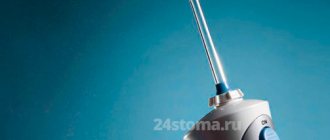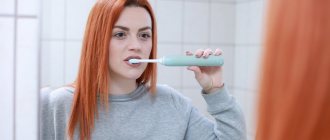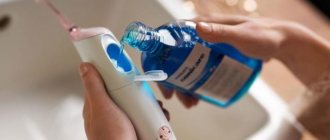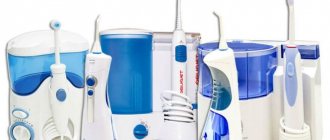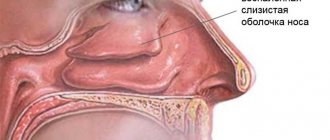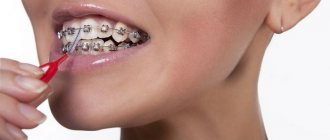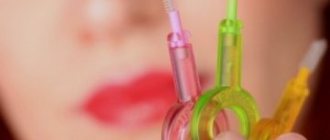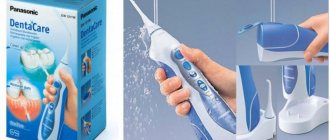Brushing your teeth after installing braces becomes more difficult. Residues of food stuck between parts of the structure cannot be removed by brushing, flossing or rinsing. This problem can be solved through daily use of an irrigator. We'll tell you which device is better to choose and how to use it when caring for braces.
In this article
- What types of irrigators are there?
- Irrigators for braces: orthodontic attachments
- Irrigator for braces - how to choose
- Rating of the best irrigators for caring for braces
- How to use a irrigator to clean braces
Braces are complex metal structures consisting of many small parts. They are placed on teeth to change their position. These orthodontic devices are non-removable. They cannot be removed before going to bed or after eating to clean and rinse. Oral care becomes more difficult. However, neglecting hygiene is dangerous. There is a risk that plaque will begin to form under the braces or carious lesions will appear. A large amount of food accumulates behind the structural elements, which cannot be removed with a regular brush. Special brushes and threads allow you to cope with this problem, but they take a lot of time. It is much faster to get your braces in order by cleaning them from food debris with an irrigator.
Oral cleaning devices are available with various attachments: standard, tongue, massage, periodontal and orthodontic. Let's try to figure out which irrigator is best to use for braces. First, let's talk about the main features of these devices.
Irrigator - a device for cleaning teeth and gums
First, let's figure out what this personal hygiene item is. The irrigator resembles an electric toothbrush with a thin tip instead of bristles. This device operates on the principle of a hydraulic compressor. Pressure is created inside the device, pushing water through the tip under high pressure. The flow of liquid washes away plaque and food particles from the teeth, cheeks, gums and tongue, thereby preventing the development of numerous dental diseases. Some experts do not recommend using the device for patients with problem gums, fearing that it may worsen the situation. However, modern devices, as a rule, have a built-in massage mode that strengthens soft tissues and improves their condition. However, people with acute inflammation should not use the device for some time.
The unique, multifunctional device JETPIK JP200 Elite combines an electric sonic toothbrush, irrigator and dental floss. The components and the device itself are stored in a convenient plastic container, which is ideal for traveling or storing in a small bathroom.
TOP models
Important! For comprehensive oral care, you need to choose a good irrigator.
We invite you to familiarize yourself with the rating of the best devices in terms of price and quality:
- Oral-B Professional Care Oxy Jet MD-20 . Smoothly adjustable jet power, large tank, four nozzles included. Circular spray mode, affordable price.
- Shenzhen Fortunecome Technology FL-V8 . Stepwise adjustment of jet pressure, three modes, two nozzles included. Charging via cable.
- Panasonic EW 1211 A. Multi-bubble technology, three modes. Wireless charging, compact.
- Device WaterPik WP-660 Aquarius Professional . Has two modes, powerful jet pressure. There are 7 nozzles and a large volume of water tank. Speed control is smooth, the nozzle rotates 360 degrees, safe to use.
- Philips AirFloss Ultra HX8432 . Spacious container for water or rinse aid, built-in battery. Injection function and spray mode, ergonomic design, power.
- Irrigator Donfeel OR-840 AIR. There are 4 attachments (orthodontic, jet, periodontal, tongue cleaning), 10 modes. Magnetic innovative attachment attachment. Quiet in operation.
- Device AQUAJET LD-A8 . Has 5 nozzles included, smooth speed control. It is compact and inexpensive.
Keep in mind! This device is not a replacement for floss and toothbrushes, but an additional tool for professional oral hygiene.
Why do you need an irrigator?
Why do you need an oral irrigator? Firstly, it copes with tasks that many toothbrushes cannot do: it removes plaque not only from the surface of the teeth, but also from hard-to-reach places: interdental spaces, as well as areas between the tooth and the gum. The accumulation of deposits in these areas that are impenetrable to brushing leads to such common diseases as cervical caries, diseases of the periodontal tissues - gingivitis and periodontitis, as well as caries of contact surfaces. Secondly, an irrigator is necessary for owners of braces, dentures, crowns, veneers, lumineers and implants. Such orthopedic or orthodontic structures make oral hygiene difficult and require special care. And finally, thirdly, the stream of water coming out of the irrigator cleans out periodontal pockets and also massages the gums, which helps strengthen them and, as a result, reduce bleeding.
Evaluation criteria
Modern models of irrigators differ from each other in the complexity of their design, the functions they perform and, of course, their design. Before you start choosing a device, it is necessary to mention some components that an irrigator for braces must have.
Cleaning modes
The features and characteristics of the various modes are shown in the following table.
Table 1. Operating modes of irrigators
| Mode | Standard | Throbbing | Microbubble |
| Mechanism of action | The jet is supplied in a continuous stream. | A pulsating jet is supplied (1200-1400 micropulses per minute), which, through intense “blows”, weakens the adhesion of bacteria and food to the tooth. | During the operation of the irrigator, the liquid mixes with air, forming microbubbles that burst, getting into the most inaccessible places. This “explosion” promotes maximum cleansing of bacteria |
| Characteristics | High flushing ability | Spot cleaning of brackets and locks, high quality cleaning of bracket systems; Additional massage of the gums, which prevents the development of bleeding and inflammation | Additionally antimicrobial effect; Eliminates bad breath; Best cleaning ability; It can even be used to rinse the nose. |
You've probably already asked yourself: which irrigator is best for braces? Let us immediately note that a device that has only a standard operating mode is not suitable for braces due to its low efficiency. The best irrigators for braces are irrigators with a pulsating or microbubble operating mode.
Jet pressure
A good device should be able to regulate the jet pressure. This criterion is important, because if you have sensitive gums, then such cleaning will not do any good, but will only damage the tissue.
The ideal jet pressure range should be from 100 to 800 kPa. The more difficult to reach areas you are going to clean, the more pressure you need to set on the device. High-quality irrigators have 10 different jet flow modes. It is worth starting with low pressures, gradually increasing the flow of the jet.
Replaceable attachments
Usually they come with an irrigator; there can be from 1 to 9 attachments. Regarding braces, a special attachment for orthodontic structures has been developed. It has a long nozzle (tip) and a narrow tip. This structure allows you to create a fine jet, making the device easier to use and increasing cleaning efficiency.
Volume for liquid reservoir
This characteristic must be taken into account for a portable irrigator. The larger the tank, the heavier your cleaner friend. For a single use, an average of 300 ml of water is required. However, there are now models on the market with a 15 ml tank! It’s hard to imagine how many teeth can be cleaned with such a volume.
Nutrition
Portable models run on batteries or batteries, while stationary models run on mains power. Charging time for the device ranges from 15 minutes to an hour. The portable irrigator can work for 30 minutes without interruption. But hardly anyone will brush their teeth for half an hour!
Varieties
Today there are a large number of irrigators, differing from each other in various parameters. Devices are divided into portable and stationary, powerful and not very powerful, with one or more nozzles and modes, with and without microbubble technology, with a water tank and with a connection to a tap, as well as with built-in dental floss, like JETPIK irrigators, in several times increasing the effectiveness of teeth cleaning. Do not also forget that each device has a certain warranty period, depending on the policy of the manufacturer. Read about how to choose the best irrigator in our other articles.
Reliable and convenient irrigator for the whole family Hydro Floss Kitty Waterjet
Instructions for use
The use of the device begins with its preparation. To do this, the tank is filled with warm water, which must be cleared of various impurities.
If the device is being used for the first time, it is necessary to perform additional cleaning by collecting a full container of water and passing it through the nozzle in the standard mode. Then set the required mode and water supply speed.
The cleansing procedure must be carried out by bending over a container or sink into which water from the oral cavity will drain.
Is it always possible to wear braces during pregnancy? We’ll talk about it in the next review.
In this material we will discuss how to correct mesial overbite.
Here https://orto-info.ru/ortodonticheskoe-lechenie/osnovnoy-period/vosk-dlya-breketov.html we’ll figure out what protective orthodontic wax for braces is.
Cleaning is carried out in several steps:
- the mouth is opened slightly so that the water can flow freely, and the nozzle is directed to the dentition, starting with the last molars;
- First, each bracket is cleaned, paying special attention to the lock and the area where the system adheres to the enamel surface;
- after this, direct the jet to the gum line area and the spaces between the teeth;
- the remaining surface of the dentition is treated last.
In conclusion, it is recommended to massage the periodontium, gently acting on it with a stream of water.
How to clean braces with an irrigator, watch the video:
After the procedure, the device must be completely emptied and dried if possible.
How to use an irrigator correctly
At first, it is recommended to set the device to the weakest setting so as not to damage soft tissues and cause pain. During cleaning, the handle of the device should be held at an angle of 90° to the surface of the teeth. You should tilt your head so that the liquid will immediately flow into the sink. How often you need to use an oral irrigator, the number of daily procedures and their duration depend on the individual characteristics of the owner of the device. For some, it will be enough to use the irrigator no more than 3 - 4 times a week for 5 minutes daily, while for others, for example, those who wear braces, crowns, implants or other structures or suffer from crowded teeth, to achieve the desired result, you should wash your teeth at least twice a day for 10-15 minutes. In any case, the plan for using the irrigator must be approved by a specialist.
By the way, some devices have a sensor installed that helps to organize the cleaning process correctly. Based on the time given to him, he independently plans the course of the procedure and “informs” his owner when he needs to move from the treated area of the oral cavity to the untouched one.
The Panasonic Dentacare Handy EW 1211 portable irrigator is one of the best devices in terms of reliability.
Equipment of the device
Modern irrigators deliver liquid under a pulsating, controlled pressure, creating a shock load on the tooth surface. It is this technology that allows you to most effectively clean the surface from any plaque and food debris.
When choosing an irrigator, the characteristics of the device will depend on the availability of the following components:
- Liquid reservoir. In order for a jet to form, a special storage tank is used, into which water or special solutions are poured.
- Amplifier. Its task is to convert electricity into mechanical energy in order to obtain the required water pressure. To achieve the required values, water pumps are used.
- External nozzle. This is the outer part of the irrigator, with the help of which an outgoing stream of liquid is formed and directed to the desired areas of the oral cavity.
When the pump is turned on, water flows from the reservoir through a special tube to the nozzle. The main technical parameters of an irrigator for cleaning teeth are the volume of the liquid reservoir and the maximum possible pressure.
How often should you use a waterpik?
Experts differ in answer to this simple question. The only thing that dentists are unanimous about is that it all depends on the condition of the oral cavity and for what purpose you are going to use the irrigator - preventatively or as part of complex therapy.
For healthy teeth
If you take care of your teeth and do not neglect daily personal hygiene, then it is enough to use the irrigator once a day for 4 days a week - solely for the purpose of preventing the formation of tartar in hard-to-reach places.
For people with bad habits
For heavy smokers, as well as those who like to abuse black coffee, tea or red wine, who are prone to the formation of dense plaque, dentists recommend using an irrigator 2 times a day every day as the final stage of oral hygiene.
During pregnancy
Women expecting a baby are extremely susceptible to any infection. Therefore, to prevent the activation of bacteria that cause caries, an irrigator is indispensable at least once a day.
For gum diseases
If you have chronic inflammatory gum diseases, such as periodontitis or gingivitis, the frequency of use of the irrigator, especially a special periodontal attachment, should be regulated by the periodontist who is observing you.
When wearing braces
Modern brace systems, despite their dramatic progress compared to the designs of 20 years ago, require increased hygiene. In this situation, it is advisable to use an irrigator after each meal during the day.
If you have dentures
The situation is similar with any removable dental prostheses: the more often and thoroughly their hygiene is carried out using an irrigator, the better and longer they will last.
Attention!
After undergoing surgical interventions in the oral cavity, the use of an irrigator should be abandoned until the time when the attending physician allows it.
Reviews
Below are some customer reviews. If you have something to say, leave your feedback in the comments below the article, it will be useful to our readers.
Natalya Ershova.
After installing braces, the dentist recommended purchasing an irrigator. I chose a landline and have never regretted the purchase.
The system copes with the task perfectly: the teeth are clean and healthy, without a hint of caries, the gums have stopped bleeding, and the braces are not damaged.
Kristina Zakharova.
I have been using the irrigator for several years now. I have it with a sprayer. Works from a power outlet, convenient to use in the bathroom.
I fill it only with filtered water - it’s safer and will last longer.
The irrigator helped a lot while wearing braces; after each meal, there was no need to clean with brushes and flosses, you just had to quickly run the jet over your teeth and everything was clean in literally a minute.
After removing the braces, I did not give up the device, I massaged my gums and their condition improved significantly.
Rules for caring for the device
The irrigator, like all electrical appliances, requires special care. The device should be washed as follows: firstly, do not under any circumstances immerse the entire irrigator in water, especially when it is turned on - it may short out (which is deadly!), and its parts may rust. Secondly, do not use unboiled water to clean the device, only filtered and, preferably, warm water. Otherwise, scale will form inside the mechanism, which will lead to its breakdown. In order to thoroughly clean the irrigator, you need to fill it exactly halfway with warm water, empty the reservoir after a couple of minutes, rinse the device and nozzles for the irrigator, and then wipe all components dry. Particularly advanced manufacturers produce devices together with a UV sanitizer designed to disinfect replaceable attachments. The ultraviolet radiation on which it works destroys microbes accumulated on the tips and thus prevents the development of dental diseases. As for the storage conditions of the irrigator, it should be kept in a dry place. Touching the appliance plug with wet hands is strictly prohibited.
In principle, the irrigator should not be cleaned too often, except for those cases when you pour special decoctions into its tank. Particles of herbs from the infusion remain inside the device and may damage its operation.
Multifunctional irrigator OR 820M Donfeel with nasal attachment
Kinds
To carry out the cleansing procedure, 3 types of irrigators are used: flow-through, stationary and portable.
All of them are used at home and do a good job of cleaning braces, but they have certain features.
Flow-through
Unlike other types, flow-type devices do not have a container for liquid. To operate, the irrigator is connected directly to the water tap using a special nozzle.
The flow-through type of device does not require preliminary water intake, and during the procedure you can use an unlimited volume of it. This system takes up little space and simultaneously with the water supply, it purifies it thanks to the built-in filter.
The disadvantage of a flow-type irrigator is that it operates in one mode and other liquids cannot be used for the procedure .
Is an electric toothbrush suitable for braces? Read our new publication.
The next article will talk about ways to correct malocclusion in adults surgically.
At the link https://orto-info.ru/ortodonticheskoe-lechenie/osnovnoy-period/uhod-za-breketami.html you will find a video with recommendations for caring for braces after installation.
Stationary
They are devices that operate from the home electrical network and are large in size. The device has a built-in storage compartment for additional attachments and a large liquid reservoir.
Even on the smallest devices, the volume of the water tank is at least 0.5 liters. The main advantage of the stationary type of irrigator is its power, which allows you to use the device in various modes with adjustable pressure, which is important for cleaning braces.
The disadvantage of this design is that when using it, it is necessary to use only filtered liquids , otherwise the device will quickly fail.
Portable
Photo: portable model of irrigator
This type is small in size and runs on a built-in battery or batteries. The portable irrigator is equipped with a small container that can hold up to 0.3 ml of liquid. This volume is enough for one cleaning procedure.
Depending on the capacity of the battery, operation of the irrigator in continuous mode and without additional recharging can last from 15 minutes to 1.5 hours. This type of irrigator also has several modes and attachments.
Its advantage is its compact size, thanks to which it does not take up much space in your bag when traveling. For frequently traveling people with braces, this device option is most suitable, as it allows high-quality cleaning of the orthodontic system in any conditions.
The disadvantages of this design include the rather large weight when the container is filled and limited modes .
How to choose a liquid for an irrigator?
When using the irrigator, special attention should be paid to the cleaning agent. Usually, irrigators come with a special balm that should be added to the water in the tank. The type of balm and the level of its concentration in water will depend on the condition of the oral cavity and the presence of certain dental problems. Some people pour regular rinse aids into the tank, but they foam quite a lot and make the cleaning process difficult. You can also use ordinary water as a cleaning agent, but only filtered water - it is safer and does not contain impurities that settle inside the device and interfere with its operation. Remember: if there is no water in the container, the irrigator cannot be turned on.
It is important to remember that it is not enough to buy an irrigator and think that it will save you from using conventional hygiene products! The device will provide a final cleaning of your teeth, removing what the toothbrush couldn’t handle. And the supplement will improve blood circulation, stimulate the renewal of soft tissues, prevent the formation of tartar and eliminate bad breath. Our Irrigator Rating 2021 will help you choose the right model.
What attachments must be included in the kit to clean braces?
The device for cleaning braces comes with various types of attachments. Each of them has its own purpose.
Standard – small hole and smoothly curved neck. Covers 1-2 teeth. Does a good job of cleaning braces.
It is worth noting! The orthodontic nozzle cleans all types of structures, including braces.
Sanitizes interdental areas and joints between teeth and gums. The neck has a narrowed tip and the tube is elongated. The pressure is strong, the stream is thin.
Massage – the nozzle is equipped with bristles, the head is rounded. Regenerates the mucous tissues of the oral cavity after surgical interventions, relieves pain, improves blood circulation.
Makes getting used to the corrective device quicker and less painful.
Periodontal – a nozzle with elastic bristles.
With its help, the liquid penetrates into the periodontal pockets and beyond the gingival margin, carefully cleaning plaque from the teeth and braces.
Key factors when choosing an irrigator
If you want to improve blood circulation in the gums, reduce the risk of inflammation and increase the service life of dental implants, using irrigators on an ongoing basis is simply necessary. Above we have presented the best model range, but if none of the options suits you for some reason, check out the parameters that will help you choose the ideal solution yourself:
- Water pressure
. The most important aspect that directly affects the quality of oral cleaning. The stronger the pressure, the more effective the irrigator, it's simple.
- Tank volume
. Consider this parameter to purchase a device that can perform its task for a long time and productively, and not require refueling every 30 seconds.
- Type of jet
. Water is supplied in different ways, most often it is a pulsating and micro-bubble type of pressure.
- Pulse frequency
. Having given preference to a pulsating jet, you need to figure out what frequency of blows is presented on the device. It would be desirable to have a separate intensity control function.
- Equipment
. A rich set is always nice, but keep in mind that much of what comes in the package can be purchased independently if the need arises.
- Type of design
. You remember that we talked about both portable and stationary irrigators. Determine your tasks and buy the right solution.
- Types of nozzles
. If you wear braces or have very sensitive gums, find out in advance whether a certain type of attachment will suit your needs or not.
The irrigator can be used for both preventive and therapeutic purposes. Doctors recommend the use of such devices for gingivitis, gum disease, periodontitis, various malocclusions and periodontal disease. In short, an irrigator is a universal solution for cleaning teeth. Choose a device based on our recommendations, then the irrigator will only delight you with taking care of your oral health.
Cleaning in a dental clinic
Various hygienic procedures at home are not a substitute for brushing teeth with braces installed at the dentist. It is recommended to perform this procedure once a month.
A professional dental cleaning removes bacteria, prevents the formation of dark plaque, and thoroughly removes food debris from the braces area.
There are different cleaning options in dental clinics:
- laser;
- special solution or substance;
- ultrasound.
After the procedure, a protective coating can be applied to the teeth, which will also saturate the teeth with fluoride.

